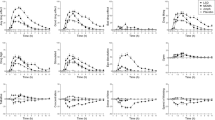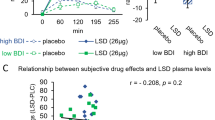Abstract
A group of ten normal human volunteers participated in choice experiments comparing d-amphetamine or diazepam with placebo and with each other. Although amphetamine was preferred to placebo by most subjects, 2 mg diazepam and placebo were chosen equally. However, placebo was chosen over higher doses (5 and 10 mg) of diazepam and 5 mg d-amphetamine was preferred to 2 mg diazepam. Subjective effects were assessed using the Profile of Mood States (POMS) before drug was taken and 1, 3, and 6 h later. Compared to placebo, amphetamine produced changes in mood on the POMS including increases in Vigor and Arousal. Doses of 5 and 10 mg diazepam produced decreases in Vigor and Arousal and increases in Fatigue and Confusion. The effects of diazepam were most pronounced 1 h after ingestion and appeared dose-dependent. For one subject who consistently chose diazepam, its subjective effects were similar to placebo and he stated that he could not distinguish them. These results are discussed in terms of the abuse liability of diazepam.
Similar content being viewed by others
References
Balster RL, Schuster CR (1973) A comparison of d-amphetamine, l-amphetamine and methamphetamine self-administration in rhesus monkeys. Pharmacol Biochem Behav 1:67–71
Bigelow G, Griffiths RR, Liebson I (1976) Effects of response requirement upon human sedative self-administration and drug-seeking behavior. Pharmacol Biochem Behav 5:681–685
Edwards AL (1972) Experimental design in psychological research. Holt, Rinehart and Winston, New York
Findley JD, Robinson WW, Peregrino L (1972) Addiction to secobarbital and chlordiazepoxide in the rhesus monkey by means of a self-infusion preference procedure. Psychopharmacologia 26:93–114
Fisher RA (1951) The design of experiments (6th edn). Oliver and Boyd, Edinburgh
Gotestam KG (1973) Intragastric self-administration of medazepam in rats. Psychopharmacologia 28:87–94
Griffiths RR, Bigelow G, Liebson I (1976) Human sedative self-administration: effects of interingestion interval and dose. J Pharmacol Exp Ther 197:488–494
Griffiths RR, Bigelow G, Liebson I (1979) Human drug self-administration: double-blind comparison of pentobarbital, diazepam, chlorpromazine and placebo. J Pharmacol Exp Ther 210:301–310
Hackett D, Hall JM (1976) Reinforcing properties of intravenous diazepam in rhesus monkeys (Macaca mulatta) with a history of codeine self-administration. Clinical Toxicology Proceeding of the 18th Meeting of the European Society of Toxicology. Duncan WAM (ed). Edinburgh, Scotland, p 308–310
Harris RT, Claghorn JL, Schoolar JC (1968) Self-administration of minor tranquilizers as a function of conditioning. Psychopharmacologia 13:81–88
Johanson CE (1978) Drugs as reinforcers In: Blackman DE, Sanger DJ (eds) Contemporary research in behavioral pharmacology. Plenum Press, New York, p 325–390
Johanson CE, Uhlenhuth EH (1980) Drug preference and mood in humans. d-Amphetamine. Psychopharmacology (in press)
Marks J (1978) The benzodiazepines use, overuse, misuse, abuse. M.T.P. Press, Lancaster, England
McNair DM, Lorr M, Droppleman LF (1971) Profile of mood states (Manual). Educational and Industrial Testing Service. San Diego
Pickens R, Harris W (1968) Self-administration of d-amphetamine by rats. Psychopharmacologia 12:158–163
Winer BJ (1971) Statistical principles in experimental design (2nd edn). McGraw-Hill, New York, p 199–200
Wise RA, Yokel RA, de Wit H (1976) Both positive reinforcement and conditioned aversion from amphetamine and apomorphine in rats. Science 191:1273–1275
Yanagita T, Takahashi S (1973) Dependence liability of several sedative-hypnotic agents evaluated in monkeys. J Pharmacol Exp Ther 185:307–316
Author information
Authors and Affiliations
Additional information
Portions of these data have been previously reported in a chapter entitled Drug Self-Administration in Humans by the same authors which appeared in Self-Administration of Abused Substances: Methods for Study. National Institute on Drug Abuse. Research Monograph Series, No. 20, pp. 68–85 (1978)
Rights and permissions
About this article
Cite this article
Johanson, C.E., Uhlenhuth, E.H. Drug preference and mood in humans: Diazepam. Psychopharmacology 71, 269–273 (1980). https://doi.org/10.1007/BF00433061
Received:
Accepted:
Issue Date:
DOI: https://doi.org/10.1007/BF00433061




